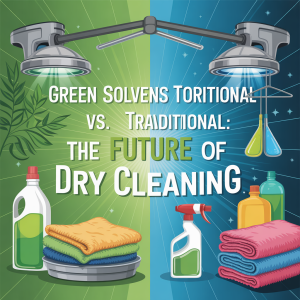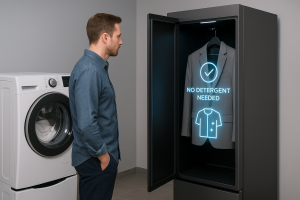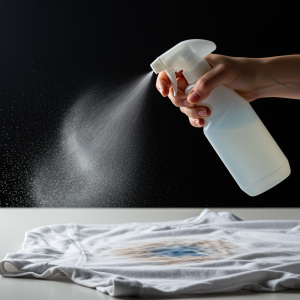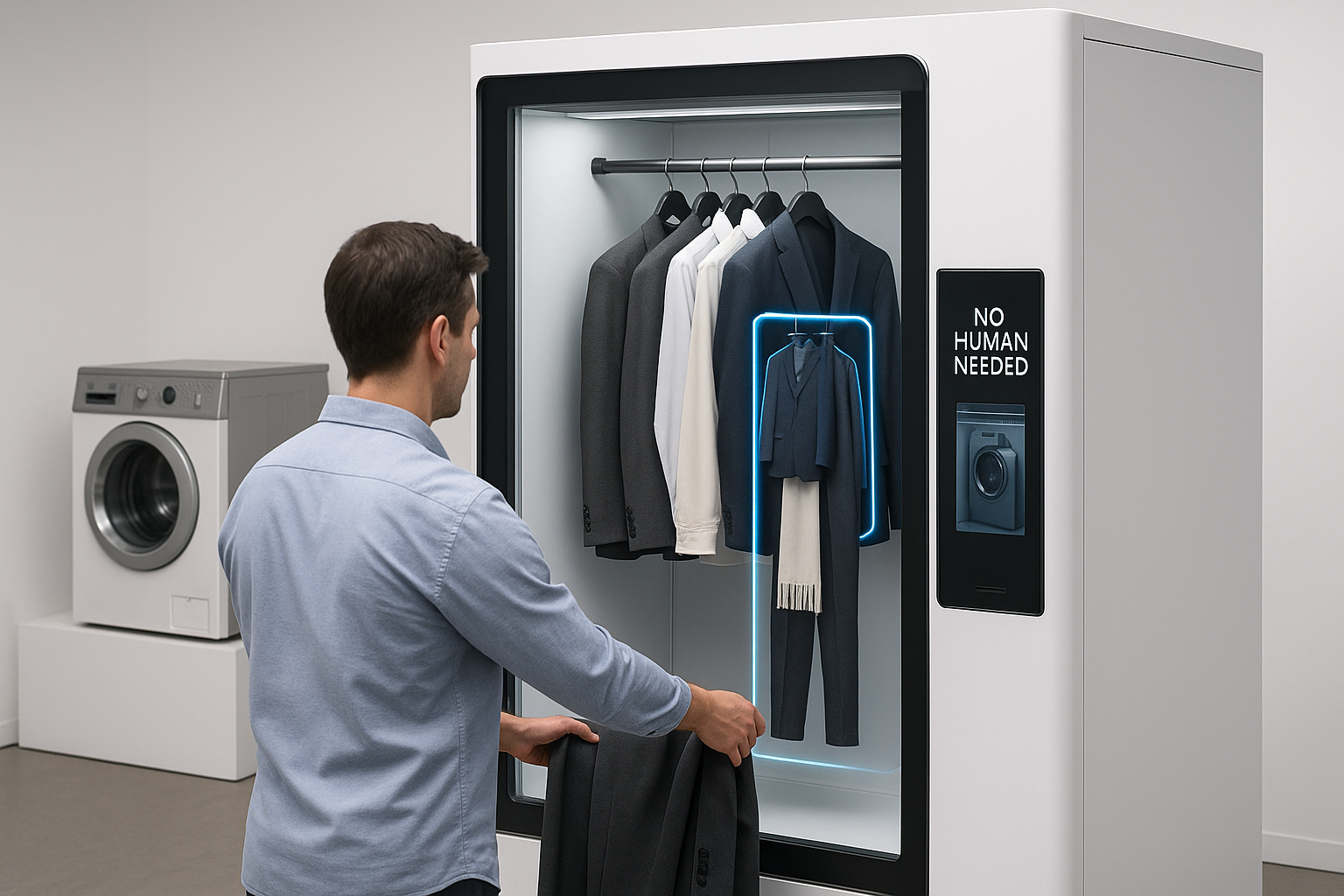The Future of Dry Cleaning: Eco-Friendly Innovation Changing the Industry in 2026
Dry Cleaning Enters a New Era
Gone are the days of harsh chemicals and outdated machinery. In 2026, the dry-cleaning industry is undergoing a radical transformation. What once relied heavily on toxic solvents and energy-intensive processes is now moving towards a future that’s greener, cleaner, and more sustainable. At the core of this revolution? Discover eco-friendly dry cleaning innovations that not only protect the planet but also extend the life of your garments. The Future of Dry Cleaning in 2026 will offer solutions that resonate with consumers seeking sustainable options.
As we delve into innovations that shape The Future of Dry Cleaning in 2026, it’s crucial to understand how these changes will impact our daily lives and the sustainability of our choices.
In this comprehensive guide, we’ll explore:
-
- The latest innovations in eco-friendly dry cleaning, including solvent alternatives, AI-powered machines, and biodegradable stain removers
- A detailed comparison between traditional and green dry-cleaning methods, highlighting cost, efficiency, environmental safety, and fabric care
- Scientifically-backed technologies such as enzyme-based cleaning agents, microplastic filters, and waterless systems, alongside practical at-home tips like steaming, stain pre-treatment, and DIY eco cleansers
- The broader impact these advancements have on customers (in terms of garment longevity and health), businesses (via operational efficiency and consumer loyalty), and the environment (through reduced waste, emissions, and water use)
- Real-world case studies from pioneering dry cleaners and insights from textile sustainability researchers pushing the boundaries of innovation
- Emerging consumer behaviours, such as the adoption of capsule wardrobes and mobile apps for finding eco-friendly cleaners, are shaping a new era of conscious garment care.
The Future of Dry Cleaning in 2026 will also see a shift towards transparency in sustainability practices.
-
Green Solvents vs. Traditional: The Future of Dry Cleaning
 Traditional: Perchloroethylene (Perc)
Traditional: Perchloroethylene (Perc)
Perchloroethylene, commonly known as Perc, has been the dominant solvent in dry cleaning since the 1930s. It’s praised for its ability to dissolve grease, oil, and stubborn stains without damaging fabrics. Because it evaporates quickly, it doesn’t require rinsing, making it seemingly efficient. But beneath the surface, its actual cost is high.
Drawbacks:
- Toxic to humans and animals: Studies have linked long-term Perc exposure to liver and kidney damage, as well as neurological effects. Dry cleaning staff are particularly vulnerable.
- Contaminates groundwater: Perc is classified as a hazardous air pollutant by the EPA and has been found in soil and groundwater near dry cleaning facilities.
- Expensive to handle and dispose of: Its use demands costly ventilation systems, waste management protocols, and insurance premiums due to liability risks.
- Regulatory pressure: Many countries, including the UK, are phasing out Perc due to its toxicity. California, for instance, has banned new Perc machines entirely since 2007.
Innovation: Liquid CO₂ and Silicone-Based Solvents
In response to environmental and health concerns, the industry is embracing next-gen solvents that match or outperform Perc, without the danger:
Exploring the themes of The Future of Dry Cleaning in 2025 reveals not only environmental benefits but also enhanced customer experiences.
- Liquid CO₂ Cleaning: This method uses carbon dioxide captured from industrial waste, pressurised into a liquid, and combined with biodegradable detergents. It’s safe, odourless, and recycles CO₂ in a closed loop, making it one of the cleanest options available.
- Green Earth (Silicone-Based): A proprietary cleaner composed of Decamethylcyclopentasiloxane (D5), which breaks down into sand, water, and CO₂. It is exceptionally gentle on delicate fabrics, such as silk, lace, and embellished materials, making it ideal for wedding gowns and couture items.
- Hydrocarbon-Based Solvents: While less eco-forward than CO₂ or silicone, hydrocarbon solvents are significantly less toxic than Perc and are gaining traction among mid-sized cleaners transitioning to greener methods.
Together, these innovations are not only reducing the environmental burden but are also offering better garment care by preventing fabric shrinkage, colour fading, and harsh chemical smells.
Comparison:
|
Feature |
Traditional Perc |
Liquid CO₂ |
Green Earth (Silicone-Based) |
|
Toxicity |
High |
None |
None |
|
Environmental Impact |
Severe |
Minimal |
Minimal |
|
Garment Longevity |
Moderate |
High |
High |
|
Odour After Cleaning |
Strong chemical |
Neutral |
Pleasant, low-scent |
|
Fabric Compatibility |
Limited (not ideal for delicate) |
Excellent |
Excellent |
|
Disposal & Waste Management |
Requires hazardous handling |
Recyclable CO₂ system |
Breaks down into sand & water |
|
Regulatory Approval |
Declining due to health risks |
Widely approved |
Certified safe in many countries |
|
Industry Adoption Rate |
Declining |
Growing rapidly |
Popular with premium services |
|
Cost Efficiency (per load) |
Moderate |
Moderate to High |
Moderate to High |
Home Remedy:
-
- For minor stains, try a vinegar and baking soda paste, a tried-and-true natural remedy that’s both affordable and effective. To create the paste, mix one tablespoon of baking soda with two tablespoons of white vinegar until a thick consistency is formed. Please apply the stain directly and gently rub it in with a soft brush or cloth. Let it sit for 15–30 minutes before rinsing with cold water. This method works exceptionally well on underarm stains, food spills, and even light coffee marks. The acetic acid in vinegar helps break down the stain’s molecules, while the alkaline baking soda acts as a mild abrasive and odour neutraliser. It’s a chemical-free approach that’s ideal for cottons and poly-cotton blends. However, always patch test first, especially on coloured or delicate garments like silk or wool.
Home practices will play a significant role in The Future of Dry Cleaning in 2026, empowering consumers to make eco-friendly choices.
The Future of Dry Cleaning in 2026 will also highlight the importance of consumer awareness and sustainable choices in garment care.
Science-backed Tip:
- Use enzyme-based detergents designed for sensitive fabrics. These detergents contain naturally derived proteins that break down organic stains such as sweat, food, and oils without the need for harsh chemicals. They’re biodegradable, making them safe for the environment, and they work effectively at lower temperatures, reducing energy usage. Unlike conventional detergents, enzyme-based formulas are gentler on fibres, which helps preserve the texture and colour of your clothes over time. Many eco-friendly dry-cleaning alternatives now incorporate enzyme-based pre-treatment sprays as the first step, ensuring a deep clean that’s both fabric-friendly and sustainable. Brands like Ecover, Bio-D, and Seventh Generation offer enzyme-rich options ideal for home use, especially when caring for delicate
- like silk, cashmere, and lace.
-
Smart Machines and Energy Efficiency in the future.
In 2025, the Future of dry cleaning will be driven by innovation, which will enhance efficiency and eco-friendliness in the industry.
Traditional Machines in The Future of Dry Cleaning:
Traditional dry-cleaning machines have served the industry for decades, but they come with a long list of inefficiencies and environmental concerns:
- Consume ample amounts of water and electricity: These machines are often not optimised for energy usage, relying on outdated motors, heating elements, and water-intensive processes that inflate utility bills and carbon emissions.
- Emit heat and VOCs (volatile organic compounds): VOCs released during the cleaning and drying cycles contribute to indoor air pollution and pose health risks to employees. The high heat needed to evaporate solvents also stresses fabrics and contributes to energy waste.
- Requires frequent maintenance due to its older technology: Mechanical wear and tear are common, resulting in frequent breakdowns and expensive service calls. Additionally, older systems struggle to adapt to newer, more delicate fabrics, which can cause damage to garments.
- Limited adaptability: Traditional machines are designed with a ‘one-size-fits-all’ approach. This means they treat heavy wool coats and lightweight silk blouses equally, often compromising the cleaning results.
- Waste-intensive operation: These systems often lack advanced filtration or solvent recovery capabilities, resulting in more chemical waste and higher disposal costs.
As consumer expectations grow and regulations tighten, the limitations of traditional machines become more pronounced, prompting many cleaners to upgrade or risk becoming obsolete.
 5 Innovation: AI-Powered and Low-Emission Equipment The Future of Dry Cleaning
5 Innovation: AI-Powered and Low-Emission Equipment The Future of Dry Cleaning
2026 brings intelligent dry-cleaning machines that do more with less—using less water, less energy, and causing far less environmental harm. These cutting-edge machines incorporate a suite of advanced technologies that make traditional equipment look ancient by comparison:
By 2026, the introduction of intelligent machines will transform The Future of dry cleaning, making it more efficient and sustainable.
The introduction of intelligent machines will be a game-changer in The Future of Dry Cleaning in 2026, offering efficiency and sustainability.
- AI Fabric Scanning: Modern machines are equipped with intelligent sensors and machine-learning algorithms that instantly identify the type of fabric, weave density, and construction of each garment. This enables the system to tailor the cleaning method, temperature, and cycle duration specifically to each item, resulting in better care and reduced risks of shrinkage or damage.
- Waterless Technology: Leveraging nano-mist systems, ultrafine steam, or even ozone-based cleaning cycles, these innovations clean garments without immersing them in water or chemical baths. Not only does this dramatically reduce water consumption, but it also shortens drying times and prevents dye bleeding or fabric stress.
- Self-cleaning filters and solvent recovery: These machines come with closed-loop filtration systems that automatically capture lint, debris, and chemical residues. Some even regenerate their cleaning solutions, reducing waste output by up to 90% compared to conventional models.
- Remote diagnostics and predictive maintenance: AI also monitors machine performance and can predict when maintenance is needed, thereby eliminating downtime, reducing service costs, and ensuring consistently high cleaning quality.
- Touchless control panels: To reduce cross-contamination and streamline operations, many competent cleaners now use voice recognition or app-based controls, enabling a hygienic, efficient, and modern user experience.
As these innovations become standard, intelligent machines are not just changing the way we clean garments—they’re redefining what it means to be a responsible, future-ready cleaner.
Comparison:
|
Feature |
Old Machines |
Smart Machines |
|
Energy Use |
High electricity and heat demand |
Low energy consumption with efficient cycles |
|
Automation |
Manual settings and adjustments |
AI-Optimised fabric-specific cycles |
|
Emissions |
High VOCs and chemical exposure |
Near-zero with closed-loop systems |
|
Fabric Handling |
One-size-fits-all approach |
Tailored settings for each garment |
|
Water Usage |
High and inefficient |
Minimal or waterless technologies |
|
Maintenance Requirements |
Frequent due to wear and tear |
Predictive and self-diagnosing |
|
Solvent Recovery |
Low or none |
Integrated solvent recycling systems |
|
User Interface |
Mechanical buttons |
Touchless, app-based, or voice control |
|
Environmental Compliance |
Increasingly non-compliant |
Designed for future sustainability standards |
At-Home Solution:
- Use a handheld garment steamer for daily refreshes. Reduces the need for frequent dry cleaning.
Scientific Proof:
- Studies show that using low-emission tech can cut carbon footprints by up to 60% compared to traditional dry cleaning. According to a 2024 white paper by the European Textile Sustainability Initiative, innovative dry-cleaning systems powered by AI and closed-loop solvents emitted 2.1 kg of CO₂ per 10 garments, compared to 5.5 kg from older Perc-based machines. Additionally, lifecycle assessments from industry pioneers like Electrolux Professional and Green Earth Cleaning confirm that integrating energy-efficient equipment with solvent recovery units can reduce both operational costs and environmental impact. These advancements are not just theoretical—they’re being implemented in real-world settings, demonstrating measurable reductions in waste output, chemical use, and energy consumption. Businesses adopting these technologies report not only sustainability benefits but also enhanced garment longevity and increased customer satisfaction.
-
Sustainable Packaging and Delivery
Sustainable packaging will also play a key role in The Future of Dry Cleaning in 2025, offering eco-friendly solutions that benefit both consumers and the planet.
Then: Plastic Galore
In the not-so-distant past, packaging and delivery in the dry-cleaning industry were major contributors to environmental waste:
- Single-use plastic bags: These thin garment covers often end up in landfills after a single use. They were non-biodegradable, added to plastic pollution, and rarely recycled by customers.
- Non-recyclable hangers: Wire hangers coated with plastic or painted finishes posed recycling challenges and frequently cluttered landfills.
- Carbon-heavy logistics: Delivery fleets powered by diesel and petrol contributed significantly to carbon emissions. Routes were inefficient, and idling vehicles further exacerbated air quality issues.
In this traditional model, sustainability was an afterthought. Most packaging was designed for convenience rather than reusability. As public awareness of environmental issues grew, this old system began to feel increasingly out of touch with modern values.
Now: Compostable, Recyclable, and Reusable
Today’s eco-conscious dry cleaners are going all in, adopting packaging and delivery innovations that drastically reduce environmental impact while improving customer experience:
- Compostable garment bags made from cornstarch or sugarcane-based bioplastics replace traditional poly film. These biodegradable bags naturally break down within 90 days in industrial composting facilities, leaving no microplastics behind. Some businesses even offer home-compostable versions.
- Recycled and reusable hangers with take-back programs are now standard. Many cleaners offer hanger return incentives—such as discounts or loyalty points—encouraging customers to bring them back instead of discarding them. Some hangers are made from recycled cardboard or bamboo for even greater sustainability.
- Electric delivery vans and bike couriers are replacing diesel-powered vehicles. These green fleets use route-optimisation software to reduce travel time and emissions. Some companies are experimenting with carbon-neutral or solar-powered delivery lockers to offer added convenience and environmental benefits.
- Branded reusable garment bags are being offered as premium options. These durable alternatives serve a dual purpose: protecting clothes and reducing waste, while also promoting brand identity every time the customer reuses them.
- Smart tracking and paperless delivery systems enable customers to track their orders in real-time, receive digital receipts, and communicate directly with the courier, eliminating the need for paper slips, plastic tags, and printed labels.
These forward-thinking initiatives not only reduce landfill contributions and emissions but also resonate strongly with environmentally conscious consumers, giving dry cleaners a competitive edge in a market that is increasingly aware of environmental concerns.
Additionally, sustainable packaging will contribute to The Future of Dry Cleaning in 2026, reducing waste and improving brand loyalty.
Comparison:
|
Feature |
Old Model |
Eco-Friendly Model |
|
Packaging Waste |
High single-use plastic bags |
Minimal, compostable, and reusable materials |
|
Hanger Sustainability |
Non-recyclable wire/plastic hangers |
Recycled cardboard, bamboo, or returnable hangers |
|
Branding & Reusability |
None |
Branded reusable garment bags for continued use |
|
Delivery Fleet |
Diesel/petrol vehicles |
Electric vans, e-bikes, and solar-powered delivery options |
|
Emissions from Transport |
High carbon footprint |
Low to zero emissions with route optimisation |
|
Customer Engagement |
Low; little interaction or education |
High loyalty rewards, sustainable education, and QR-code tracking |
|
Receipt & Tracking Systems |
Paper slips, manual systems |
Paperless, digital receipts and real-time tracking |
|
Brand Perception |
Outdated, convenience-first |
Innovative, sustainability-focused |
Home Practice:
- Bring your garment bag or request that no plastic be used. Not only does this reduce your plastic consumption, but it also sends a clear message to your cleaner that sustainability is essential. Opt for reusable garment bags made from organic cotton, hemp, or recycled polyester. Many of these come with zippers, handles, and breathable panels, offering better protection for your clothes than thin plastic. Ask your dry cleaner if they support take-back programs or will store your reusable bag for your next visit. By taking this simple step, you’re helping to shift industry norms and reduce the staggering amount of single-use plastic waste generated annually by dry cleaning services.
Pro Insight:
- Companies that use sustainable delivery and packaging methods see a 15-20% increase in customer retention. In a market increasingly influenced by consumer values, customers are more likely to return to businesses that align with their environmental and ethical concerns. Sustainable practices are no longer viewed as optional—they’re seen as a competitive advantage. Businesses that incorporate green solutions often report increased customer referrals, stronger brand loyalty, and even higher customer satisfaction ratings. It’s not just good for the Earth—it’s a strategic business decision that pays off in both reputation and revenue.
-
Biodegradable Spot Treatments and Stain Removers
As we explore the innovations in The Future of Dry Cleaning in 2026, we see a shift toward biodegradable solutions that are more environmentally friendly.
 Before: Solvent-heavy Stain Fighters
Before: Solvent-heavy Stain Fighters
Old-school methods for removing stains in dry cleaning primarily relied on petrochemical-based agents such as perchloroethylene, trichloroethylene, and various petroleum derivatives. These chemicals, while effective at dissolving grease and organic stains, have several downsides. They leave behind chemical residues on garments, contribute to air and water pollution, and emit strong, unpleasant odours that often linger on clothing.
These solvents are also harsh on fabrics over time, weakening fibres, fading colours, and reducing garment longevity, particularly for delicate materials like silk, lace, or cashmere. Additionally, many of these substances are classified as hazardous by environmental agencies. They require special handling, ventilation systems, and proper disposal methods, which increase both the operational costs and environmental risks associated with traditional dry-cleaning practices.
From a health perspective, prolonged exposure to these solvents—especially in poorly ventilated cleaning shops—has been linked to respiratory issues, skin irritation, and even long-term neurological effects. With growing awareness of these dangers, both consumers and regulators are demanding safer, cleaner alternatives that don’t sacrifice performance for environmental and personal health.
The Shift: Plant-Based and Enzyme Solutions
Plant-based and enzyme-based stain removers represent a significant leap in eco-conscious garment care. These alternatives rely on ingredients like citrus extracts, coconut oil derivatives, corn-based surfactants, and specific enzymes designed to break down organic stains without damaging fibres or polluting waterways.
- Derived from natural sources: Citrus fruits provide natural degreasers (limonene), while coconut and corn yield surfactants and enzymes that target protein-based stains like sweat, wine, or food residues. These ingredients are non-toxic, renewable, and often ethically sourced.
- Highly effective yet gentle: Unlike harsh chemical solvents, these solutions lift stains through biochemical reactions that break down stains at a molecular level. They’re especially ideal for delicate fabrics such as silk, wool, or lace, which conventional solvents can damage.
- Biodegradable and water-safe: These treatments are engineered to break down quickly and safely in wastewater systems. This ensures they don’t contribute to aquatic toxicity or groundwater pollution, a significant advancement over older stain-fighting chemicals.
- Customisable enzyme blends: Enzyme cleaners can be tailored to target specific stain types—lipase for oils, protease for blood or sweat, and amylase for starch-based stains. This makes them more precise and efficient in professional cleaning environments.
- Proven performance: Brands like Bio-D, Puracy, and Seventh Generation have undergone third-party testing to verify stain removal efficacy. Their success in consumer markets and professional settings alike underscores the potential of green science in transforming dry cleaning practices.
Comparison:
|
Stain Treatment |
Traditional |
Eco-Friendly |
|
Residue Left |
Yes |
No |
|
Suitable for Delicates |
Sometimes |
Always |
|
Environmental Safety |
Low |
High |
DIY Option:
- Use a mixture of lemon juice and salt for a natural brightening effect.
Lab-Tested Upgrade:
- Try biodegradable enzymatic pre-treaters, such as Puracy or Ecover, for delicate silks and linens.
-
Microplastic Filtering and Fabric Protection
Problem: Microfiber Pollution
Efforts to combat microfiber pollution will be crucial in The Future of Dry Cleaning in 2026, ensuring a cleaner environment.
Every time we wash synthetic fabrics—like polyester, nylon, or acrylic—tiny plastic fibres called microplastics are released. These fibres are too small to be caught by standard wastewater treatment facilities and end up in our rivers, oceans, and even the food chain. It’s estimated that a single load of laundry can release up to 700,000 microfibers into the environment.
Efforts to combat microplastic pollution will be crucial in The Future of Dry Cleaning in 2026, ensuring cleaner waterways.
Microplastic pollution isn’t just an environmental hazard; it poses long-term risks to marine life and human health. These invisible threads are now found in fish, drinking water, and even the air we breathe.
2026 Solution: Tech Meets Sustainability
Innovators in the dry-cleaning industry are tackling microfiber pollution head-on:
- In-drum microfiber filters: Advanced commercial and residential washers now include internal filtration systems that capture up to 90% of microfibers during the cleaning process.
- Specialised dry-cleaning bags: High-tech reusable bags not only shield clothes during the cleaning process but also trap microfibers before they escape into the waste stream.
- Upcycled mesh wash bags: For home users, products like the Guppyfriend and Cora Ball allow consumers to protect clothes and the environment by collecting microfibers before they can flow into drains.
- Bioengineered fabrics: Some manufacturers are creating biodegradable synthetic blends that reduce shedding or break down harmlessly in nature.
These innovations are gradually becoming industry standards, and many green dry cleaners are encouraging their customers to adopt them at home as well. At Hampstead Garment Care, we actively promote the use of microfiber-capture accessories and partner with suppliers who share our commitment to sustainability.
Long-Term Vision:
Imagine a closed-loop system where every piece of clothing is tracked from production to disposal. Filters are automatically cleaned and emptied by intelligent systems. Fabrics are redesigned to be both functional and eco-responsible. And every customer becomes part of the solution simply by choosing the right bag or cleaner.
Ultimately, the vision for The Future of Dry Cleaning in 2026 includes a closed-loop system that prioritises sustainability.
This vision isn’t science fiction—it’s on the 5-year roadmap of multiple sustainability-focused textile researchers and EU legislation initiatives.
By taking proactive steps today, we’re helping ensure a future where fashion and function no longer come at the cost of our oceans.
Comparison:
|
Feature |
Traditional Cleaning |
Microplastic-Aware Cleaning |
|
Fiber Shedding |
High |
Low |
|
Water Contamination |
Severe |
Controlled |
|
Innovation Level |
Low |
Cutting-edge |
At-Home Tip:
- Wash synthetic garments in a Guppyfriend bag to reduce pollution. These specially designed wash bags are made from ultra-dense, monofilament polyester that traps microfibers shed during washing. Place synthetic garments—such as polyester shirts, nylon tights, or fleece jumpers—inside the bag before adding them to the washing machine. The Guppy friend reduces fibre breakage and captures up to 86% of released microplastics, which can then be collected and disposed of responsibly. It’s a simple yet powerful tool that protects both your clothes and the waterways from invisible plastic pollution. Ideal for eco-conscious households, it’s also endorsed by environmental groups such as Friends of the Earth and the Plastic Soup Foundation.
Industry Insight:
- EU studies show fibre-filtering tech in commercial machines could prevent over 500,000 tonnes of microplastics annually—the equivalent of stopping the release of nearly 50 billion plastic bottles into the environment. These advanced filtration systems work by capturing microscopic fibres at the source before they can flow into wastewater systems. In pilot programs across France, Germany, and the Netherlands, commercial laundries that implemented microfiber filters reported a reduction of up to 80–90% in fibre release. Furthermore, upcoming EU legislation may soon mandate the use of microfiber filters in both residential and commercial machines by 2027, thereby accelerating their widespread adoption. Industry experts believe this could be one of the most impactful interventions in reducing textile-related pollution in the next decade.
-
Consumer Behaviour: Awareness = Change
The emphasis on eco-friendly practices will be a hallmark of The Future of Dry Cleaning in 2026 as consumers demand change.
Eco-friendly dry cleaning isn’t just about technology. It’s about people making better choices.
What Customers Are Doing:
- Choosing eco-friendly cleaners: Consumers are actively seeking out dry cleaners that prioritise sustainability, often researching reviews, certifications (such as Green Earth or ISO 14001), and solvent choices before committing.
- Asking questions about solvents and processes: Customers are more informed than ever. They inquire about the solvents being used, whether the machines are energy-efficient, and whether the packaging is recyclable or compostable.
- Reducing the frequency of dry cleaning: With growing awareness of garment longevity and energy use, many customers now opt to steam, air out, or gently hand-wash clothes between professional cleanings. Some are even grouping their items into fewer but larger loads to reduce their carbon footprint.
- Shifting to capsule wardrobes: Fewer garments, better quality. The minimalist wardrobe trend is gaining popularity, and it supports sustainable dry cleaning by promoting longer wear and less frequent cleaning.
- Using tech to choose providers: Apps and websites are emerging that rate and recommend eco-conscious garment care providers, giving customers easier access to greener options.
What Businesses Are Offering:
- Loyalty points for sustainable choices: Forward-thinking dry cleaners now reward customers who make environmentally conscious decisions, such as reusing hangers or opting out of plastic wrap. These points can be exchanged for discounts, free services, or eco-gift bundles.
- Transparency in cleaning methods: Leading dry-cleaning businesses are no longer hiding behind the curtain. They proudly display their eco-certifications, detailing the solvents they use, and demonstrate to customers how their equipment reduces emissions. This builds trust and strengthens customer loyalty.
- Education through blogs, tags, and QR codes: QR codes on receipts or hang tags now direct customers to breakdowns of cleaning methods, sustainability blogs, or videos showcasing behind-the-scenes practices. Businesses are becoming educators, helping clients make informed decisions about garment care.
- Partnerships with ethical brands: Many eco-dry cleaners are collaborating with sustainable fashion designers, laundry detergent makers, and textile recyclers to promote a full-circle garment care ecosystem. These partnerships expand their audience and amplify their values.
- Subscription-based green plans: Some businesses are offering monthly eco-cleaning subscriptions, allowing customers to budget for dry cleaning while reducing their carbon footprint with every load.
Social Shift:
- A 2024 study by the Clean Clothes Campaign found that 72% of UK customers now prefer green garment care options. This trend is especially pronounced among Gen Z and Millennial consumers, who prioritise sustainability over price in many purchasing decisions. As this demand grows, businesses that fail to innovate risk falling behind.
Conclusion: It’s Not Just Clean — It’s Conscious
The dry-cleaning industry in 2025 is changing not just how clothes are cleaned, but why they’re cleaned that way. With eco-friendly innovations leading the charge, businesses like Hampstead Garment Care are embracing a cleaner, brighter, and more sustainable future.
As we look forward, The Future of Dry Cleaning in 2026 encapsulates a commitment to both garment care and environmental responsibility.
This shift toward sustainability encapsulates The Future of Dry Cleaning in 2026, fostering a deeper connection between consumers and their choices for garment care.
The takeaway? Being kind to your clothes and the environment doesn’t mean compromising on quality. The future of garment care is looking sharper, greener, and more intelligent than ever.
In essence, The Future of Dry Cleaning in 2026 represents a commitment to environmental responsibility while maintaining high standards of garment care.
🌍 Want to experience dry cleaning reimagined? Book online today and join the sustainable revolution.
Join us in exploring The Future of Dry Cleaning in 2026 and how it transforms the garment care landscape.
Discover how The Future of Dry Cleaning in 2026 transforms the garment care landscape towards a more sustainable future.



No comment